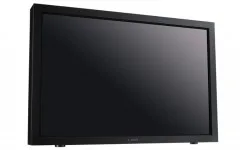Canon offers two reference displays at 24 inches (DP-V2410) and 30 inches (DP-V3010). Both offer DCI-4K resolution 4096×2160) and a wide color gamut (essentially P3, not 2020). Both are targeted at broadcast and cinema production as well as medical applications.
Both will apparently be offered in 200 and 2000 cd/m² versions and both support HDR grading. Included is support for the SMPTE 2084 PQ curve as well as Canon log/Log2 gamma curves output by the Canon EOS cinema grade cameras.
The color capabilities on the display are interesting. While the display uses RGB LEDs in the backlight and a 10-bit IPS LCD panel, the real color primaries are nearer to the P3 than 2020 gamut. Canon says the monitors support a 2020 and ACES 1.0 color workflow, but it can only accurately reproduce colors within the DCI-P3 gamut (which includes 709 and SMPTE-C gamuts as well). The monitors can also de-Bayer incoming RAW data from the Canon EOS C500 and C300 Mark II in real time.

That means colors within the P3 gamut can be rendered natively, but colors outside the gamut are not. According to Canon’s Joe Bogacz, there are two options in this case. One is to desaturate the color along the axis back to the white point to the edge of the P3 gamut. The other is to use some perceptual rendering to make the color appear a bit brighter just as it would if the fully saturated color could be displayed (using the H-K effect).
Bogacz also noted the monitors have an auto-calibration capability. “At NAB we used the monitor’s automated color calibration capability to set it to P3 and then compared it to a color calibrated Barco projector we also had in the booth. I was amazed that the color matched.”
At the Canon EXPO, they showed a similar set up as at NAB and Display Summit with live capture to display in HDR as you would in a color grading suite. The 2000 nit monitors were used to show 4K content at 60 and 24 fps, while a 200 nit monitor also showed 4K/24 fps content.
Finally, we saw prototype 28-inch 8K monitors. Images from a 5DS 50 megapixel camera were shown on two monitors and video from an EOS cinema camera were shown on the other two. Interestingly, the video images looked better.
Little information was available on the specifications and the company was vague on the HDR capabilities of the monitor. However, the contrast was very high and the highlights had high luminance, which leads me to conclude we were seeing HDR content.

